Though somewhat similar in appearance, lucky bamboo is not the same thing as the stuff you may see growing wildly quickly along your neighbor's property line. Lucky bamboo is part of the
Dracaena genus, and most of us will recognize it as the ubiquitous gift plant seen growing in pebble-filled glass containers filled with water. But this plant is not all novelty. It's a wonderful, versatile species that's able to thrive in many areas of the home or office where other plants may not, and can be used as an attractive, living design element that complements a wide range of furnishings.
Whether you prefer the clean look of naturally straight stems growing in a simple glass vase, or an ornate container with twisted stalks, this plant delivers. It is hardy, but you'll have to follow some basic tenets for it to survive. Here's how to get the most out of your lucky bamboo.
Caution: Lucky bamboo can be toxic to certain pets if ingested. See other plants to keep away from pets
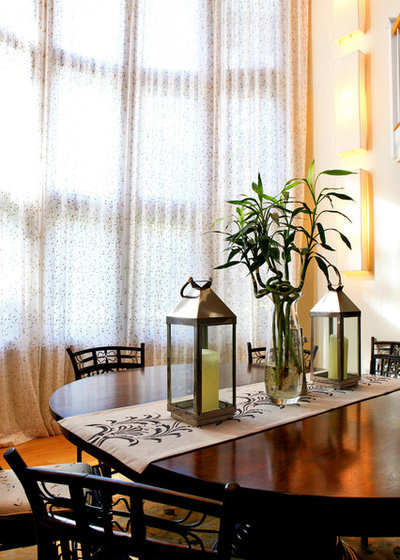
moment design + productions, llc
In this elegant beach house, lucky bamboo has abandoned its Asian design associations and takes on tropical plantation style. Used in a casual bouquet-like arrangement, in a vase with soft edges as opposed to the rectilinear containers it's usually grown in, lucky bamboo has a different look altogether.
It also has an intriguing history, which can be traced back to Chinese culture 4,000 years ago (though it's native to West Africa), when it was considered a symbol of good fortune. While this plant is often thought of as a member of the bamboo family, in reality it's more closely related to lilies; its botanical name is
Dracaena sanderiana.
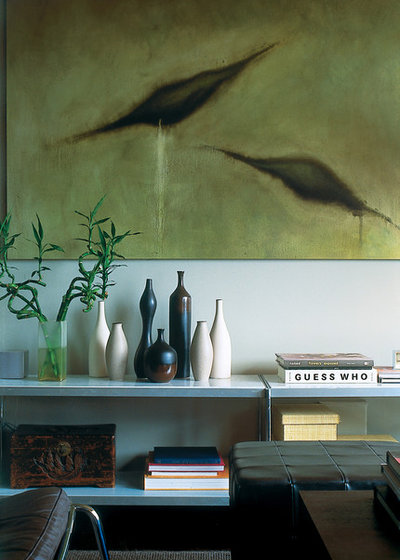
Cary Bernstein Architect
Lucky bamboo is at home beside a collection of curvy modern vases and abstract art here.
Twisted stalks are a relatively new feature of lucky bamboo, a novelty that has aided in the plant's popularity. Straight stalks can be manipulated as they grow by rotating the plant with respect to gravity and light sources. This is difficult to achieve at home, but it's not impossible with some spare time and a lot of patience — often years' worth.
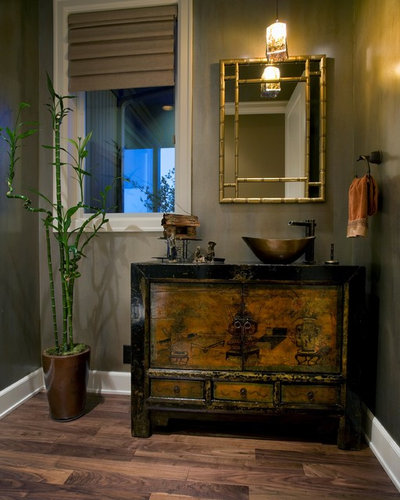
Kaufman Homes, Inc.
A very tall lucky bamboo plant grown in soil provides a living accent in this area between an Asian-style cabinet and a wall. It's a perfect complement to the gold-framed mirror with bamboo detailing.
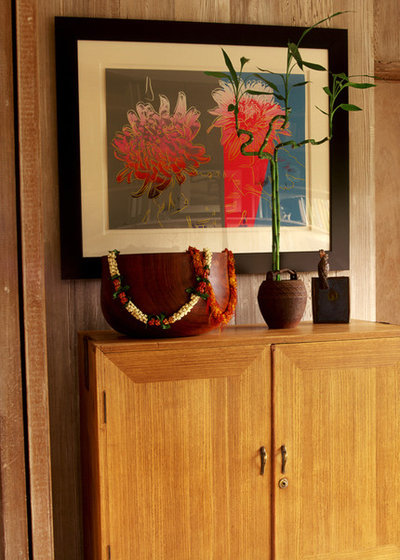
Philpotts Interiors
Lucky bamboo takes on a mysterious air here. The wispy stalks look almost like curling smoke from incense sticks or ribbons waving in the wind.
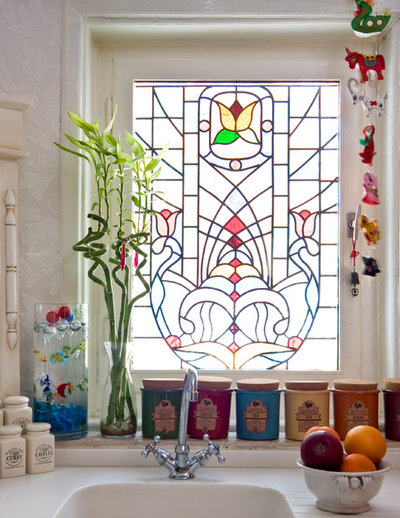
gogo gulgun selcuk
In a cheerful Turkish kitchen, this simple arrangement of curled lucky bamboo looks like a prop from a medieval fair. It takes up minimal space, but its height gives it the impact of a larger plant.
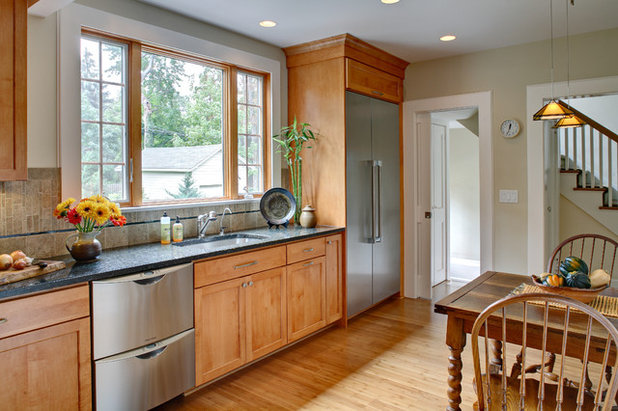
Tracey Stephens Interior Design Inc
A traditional kitchen with a long counter always looks great with some greenery. Instead of a topiary, try a vase filled with lucky bamboo and a few pieces of pottery.
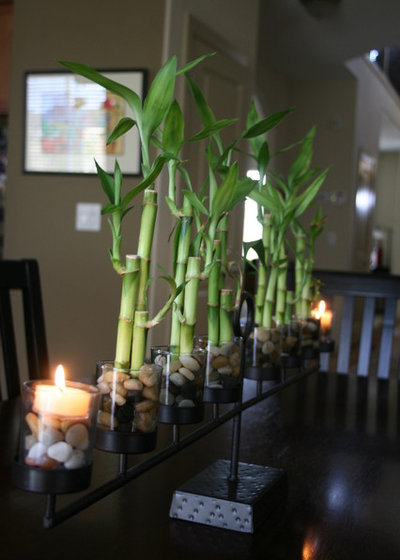
This clever homeowner uses a candelabra to hold both candles and lucky bamboo, with great results.
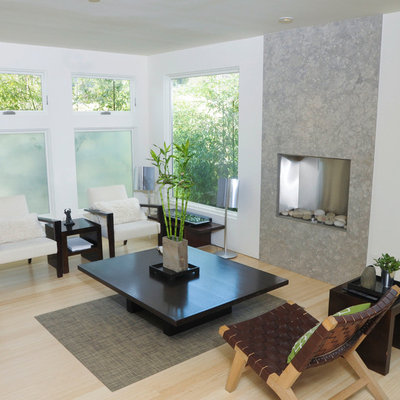
Heydt Designs
Tall stalks of curled lucky bamboo look fabulous on this low coffee table, balancing the fireplace surround with its height and color. The touch of green connects the neutral living room to the outdoors, and specifically to large containers of authentic bamboo on the porch just beyond.
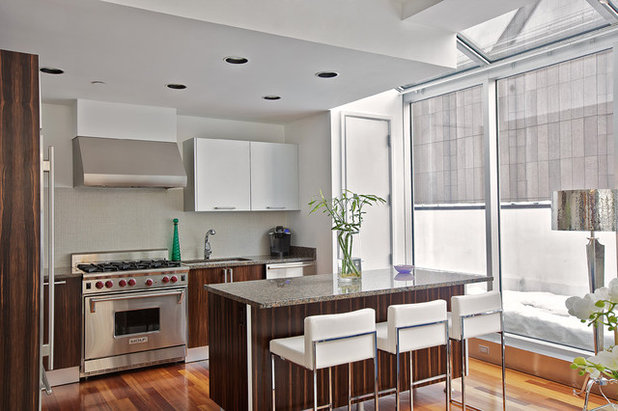
Marie Burgos Design
A casual arrangement of lucky bamboo in a glass vase gives the impression of an elegant bouquet of flowers, but it's a one-time investment that will thrive for years.
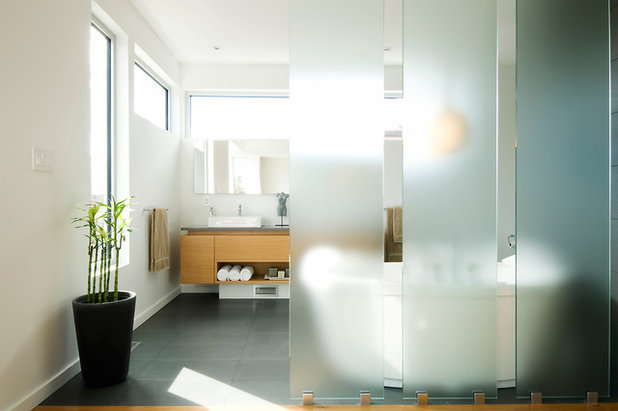
Linebox Studio
A pot of lucky bamboo makes a modern statement, defining the opening to this sleek bathroom, where it's placed just out of reach of the sun's direct rays.
How to care for lucky bamboo:- Temperature: It prefers 59 to 77 degrees Fahrenheit (15 to 25 degrees Celsius).
- Light: Provide bright, indirect lighting; avoid direct sunlight. It's more tolerant of too little light than too much. If the plant begins to stretch toward the light, or the green color of its leaves fades, then the light is too low.
- Water: Change the water every one to two weeks. Use bottled spring water for fast growth and a beautiful deep green color; tap water contains chemicals and additives that can sicken or even kill the plant. For plants raised in soil, keep the soil evenly moist.
- Soil: Use well-draining, rich potting soil.
- Feeding: Use a liquid fertilizer recommended by the manufacturer, diluted to half strength, no more than once every two months. For plants growing in water, you can use liquid aquarium plant food. Specialty lucky bamboo fertilizers are available.
- Container: Grow lucky bamboo in a tall glass vase or ceramic container; shallow bowls are not advised. The water level should be constantly maintained to be 1 to 3 inches. A higher water level allows more root growth, resulting in a greater amount of top growth.
- Propagation: New stalks can be grown from original ones. Make a clean cut through the stalk, seal the top with melted wax and place the cut piece in water treated with a rooting hormone. (Follow the directions on the package.) Refresh the water weekly.
Problem solving:- If your plant emits a foul odor, it has very likely begun to rot due to water contamination. Throw the plant out and start again, or salvage any healthy portions of stalk and root them in water (see "Propagation" above). If there are side shoots on the stalk, you can cut these off and place them in water to make new tiny plants.
- Never allow dead leaves to stay in water; cut away any black roots.
- Mature roots are naturally red and not a sign of plant distress.
- Yellow leaves may be caused by too much direct light; overcrowded roots; chlorinated, salty or softened water; or too much fertilizer.
- Brown leaves usually indicate overly dry air or polluted water.





